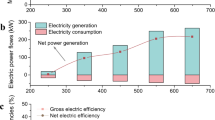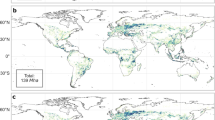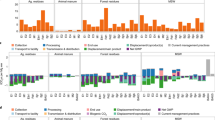Abstract
Bioenergy with carbon capture and storage (BECCS) can act as a negative emission technology and is considered crucial in many climate change mitigation pathways that limit global warming to 1.5–2 °C; however, the negative emission potential of BECCS has not been rigorously assessed. Here we perform a global spatially explicit analysis of life-cycle GHG emissions for lignocellulosic crop-based BECCS. We show that negative emissions greatly depend on biomass cultivation location, treatment of original vegetation, the final energy carrier produced and the evaluation period considered. We find a global potential of 28 EJ per year for electricity with negative emissions, sequestering 2.5 GtCO2 per year when accounting emissions over 30 years, which increases to 220 EJ per year and 40 GtCO2 per year over 80 years. We show that BECCS sequestration projected in IPCC SR1.5 °C pathways can be approached biophysically; however, considering its potentially very large land requirements, we suggest substantially limited and earlier deployment.
This is a preview of subscription content, access via your institution
Access options
Access Nature and 54 other Nature Portfolio journals
Get Nature+, our best-value online-access subscription
$29.99 / 30 days
cancel any time
Subscribe to this journal
Receive 12 print issues and online access
$209.00 per year
only $17.42 per issue
Buy this article
- Purchase on Springer Link
- Instant access to full article PDF
Prices may be subject to local taxes which are calculated during checkout





Similar content being viewed by others
Data availability
Data supporting the findings of this study are available within the paper and its Supplementary Information. All source data for figures and datasets generated during the current study are available online at https://doi.org/10.17026/dans-x73-tqeg. Source data for figures in the Supplementary Information are available from the corresponding author on reasonable request.
Code availability
The code used in the analyses of the current study is available from the corresponding author on reasonable request.
References
Azar, C., Johansson, D. J. A. & Mattsson, N. Meeting global temperature targets—the role of bioenergy with carbon capture and storage. Environ. Res. Lett. 8, 034004 (2013).
Tavoni, M. & Socolow, R. Modeling meets science and technology: an introduction to a special issue on negative emissions. Climatic Change 118, 1–14 (2013).
Clarke, L. et al. in Climate Change 2014: Mitigation of Climate Change (eds Edenhofer, O. et al.) 413–510 (IPCC, Cambridge Univ. Press, 2014).
Fuss, S. et al. Research priorities for negative emissions. Environ. Res. Lett. 11, 115007 (2016).
Smith, P. et al. Biophysical and economic limits to negative CO2 emissions. Nat. Clim. Change 6, 42–50 (2016).
Van Vuuren, D. P. et al. Alternative pathways to the 1.5 °C target reduce the need for negative emission technologies. Nat. Clim. Change 8, 391–397 (2018).
Rogelj, J. et al. in Global Warming of 1.5 °C (eds Masson-Delmotte, V. et al.) 93–174 (in the press).
Obersteiner, M. et al. Managing climate risk. Science 294, 786–787 (2001).
Gough, C. & Upham, P. Biomass energy with carbon capture and storage (BECCS or Bio-CCS). Greenh. Gases 1, 324–334 (2011).
Kemper, J. Biomass and carbon dioxide capture and storage: a review. Int. J. Greenh. Gas. Con. 40, 401–430 (2015).
Bonsch, M. et al. Trade-offs between land and water requirements for large-scale bioenergy production. GCB Bioenergy 8, 11–24 (2016).
Fajardy, M., Chiquier, S. & Mac Dowell, N. Investigating the BECCS resource nexus: delivering sustainable negative emissions. Energy Environ. Sci. 11, 3408–3430 (2018).
Heck, V., Gerten, D., Lucht, W. & Popp, A. Biomass-based negative emissions difficult to reconcile with planetary boundaries. Nat. Clim. Change 8, 345–345 (2018).
Stoy, P. C. et al. Opportunities and trade-offs among BECCS and the food, water, energy, biodiversity, and social systems nexus at regional scales. BioScience 68, 100–111 (2018).
Kato, E. & Yamagata, Y. BECCS capability of dedicated bioenergy crops under a future land-use scenario targeting net negative carbon emissions. Earth’s Future 2, 421–439 (2014).
Fuss, S. et al. Negative emissions—part 2: costs, potentials and side effects. Environ. Res. Lett. 13, 063002 (2018).
Fridahl, M. & Lehtveer, M. Bioenergy with carbon capture and storage (BECCS): global potential, investment preferences, and deployment barriers. Energy Res. Soc. Sci. 42, 155–165 (2018).
Torvanger, A. Governance of bioenergy with carbon capture and storage (BECCS): accounting, rewarding, and the Paris Agreement. Clim. Policy 19, 329–341 (2019).
Bednar, J., Obersteiner, M. & Wagner, F. On the financial viability of negative emissions. Nat. Commun. 10, 1783 (2019).
Daggash, H. A. & Mac Dowell, N. Higher carbon process on emissions alone will not deliver the Paris Agreement. Joule 3, 1–14 (2019).
Fajardy, M. & Mac Dowell, N. Can BECCS deliver sustainable and resource efficient negative emissions? Energy Environ. Sci. 10, 2267–2267 (2017).
Harper, A. B. et al. Land-use emissions play a critical role in landbased mitigation for Paris climate targets. Nat. Commun. 9, 2938 (2018).
Elshout, P. M. F. et al. Greenhouse-gas payback times for crop-based biofuels. Nat. Clim. Change 5, 604–610 (2015).
Daioglou, V. et al. Greenhouse gas emission curves for advanced biofuel supply chains. Nat. Clim. Change 7, 920–924 (2017).
Searchinger, T. et al. Use of U.S. croplands for biofuels increases greenhouse gases through emissions from land-use change. Science 319, 1238–1240 (2008).
Gerssen-Gondelach, S. J., Wicke, B. & Faaij, A. P. C. GHG emissions and other environmental impacts of indirect land use change mitigation. GCB Bioenergy 9, 725–742 (2017).
Hasegawa, T. et al. Risk of increased food insecurity under stringent global climate change mitigation policy. Nat. Clim. Change 8, 699–703 (2018).
Doelman, J. C. et al. Exploring SSP land-use dynamics using the IMAGE model: regional and gridded scenarios of land-use change and land-based climate change mitigation. Glob. Environ. Change 48, 119–135 (2018).
Fujimori, S. et al. A multi-model assessment of food security implications of climate change mitigation. Nat. Sustain. 2, 386–396 (2019).
Creutzig, F. et al. Bioenergy and climate change mitigation: an assessment. GCB Bioenergy 7, 916–944 (2015).
IEA Key Energy Statistics 2018 (OECD/IEA, 2018); https://www.iea.org/reports/key-world-energy-statistics-2019
UN UNdata Gas Oil/Diesel Oil (UN Statistics Division, 2019); https://data.un.org/
Blakey, S., Rye, L. & Wilson, C. W. Aviation gas turbine alternative fuels: a review. Proc. Combust. Inst. 33, 2863–2885 (2011).
Hanssen, S. V., Duden, A. S., Junginger, H. M., Dale, V. H. & van der Hilst, F. Wood pellets, what else? Greenhouse gas parity times of European electricity from wood pellets produced in the south-eastern United States using different softwood feedstocks. GCB Bioenergy 9, 1406–1422 (2017).
Huppman, D. et al. IAMC 1.5 °C Scenario Explorer and Data hosted by IIASA (IAMC/IIASA 2019); https://doi.org/10.5281/zenodo.3363345
Obersteiner, M. et al. How to spend a dwindling greenhouse gas budget. Nat. Clim. Change 8, 7–10 (2018).
Lundmark, T., Bergh, J., Nordin, A., Fahlvik, N. & Poudel, B. C. Comparison of carbon balances between continuous-cover and clear-cut forestry in Sweden. Ambio 45, 203–213 (2016).
Peura, M., Burgas, D., Eyvindson, K., Repo, A. & Mönkkönen, M. Continuous cover forestry is a cost-efficient tool to increase multifunctionality of boreal production forests in Fennoscandia. Biol. Conserv. 217, 104–112 (2018).
Kuuluvainen, T. & Gauthier, S. Young and old forest in the boreal: critical stages of ecosystem dynamics and management under global change. For. Ecosyst. 5, 5–26 (2018).
Zabel, F., Putzenlechner, B. & Mauser, W. Global agricultural land resources—a high resolution suitability evaluation and its perspectives until 2100 under climate change conditions. PLoS ONE 9, e107522 (2014).
De Coninck, H. et al. in Global Warming of 1.5 °C (eds Masson-Delmotte, V. et al.) 313–443 (in the press).
Chaudhary, A., Verones, F., de Baan, L. & Hellweg, S. Quantifying land use impacts on biodiversity: combining species-area models and vulnerability indicators. Environ. Sci. Technol. 49, 9987–9995 (2015).
Hof, C. et al. Bioenergy cropland expansion may offset positive effects of climate change mitigation for global vertebrate diversity. Proc. Natl Acad. Sci. USA 115, 13294–13299 (2018).
Scott, V., Haszeldine, R. S., Tett, S. F. B. & Oschlies, A. Fossil fuels in a trillion tonne world. Nat. Clim. Change 5, 419–423 (2015).
Baik, E. et al. Geospatial analysis of near-term potential for carbon-negative bioenergy in the United States. Proc. Natl Acad. Sci. USA 115, 3290–3295 (2018).
Haszeldine, R. S., Flude, S., Johnson, G. & Scott, V. Negative emissions technologies and carbon capture and storage to achieve the Paris agreement commitments. Philos. Trans. R. Soc. 376, 20160447 (2018).
Turner, P. A. et al. The global overlap of bioenergy and carbon sequestration potential. Climatic Change 148, 1–10 (2018).
Van Vuuren, D. P., Hof, A. F., van Sluisveld, M. A. E. & Riahi, K. Open discussion of negative emissions is urgently needed. Nat. Energy 2, 902–904 (2017).
Sanchez, D. L., Johnson, N., McCoy, S. T., Turner, P. A. & Mach, K. J. Near-term deployment of carbon capture and sequestration from biorefineries in the United States. Proc. Natl Acad. Sci. USA 115, 4875–4880 (2018).
Turner, P. A., Field, C. B., Lobell, D. B., Sanchez, D. L. & Mach, K. J. Unprecedented rates of land-use transformation in modelled climate change mitigation pathways. Nat. Sustainability 1, 240–245 (2018).
Grubler, A. et al. A low energy demand scenario for meeting the 1.5 °C target and sustainable development goals without negative emission technologies. Nat. Energy 3, 515–527 (2018).
Hanssen, S. V. et al. Biomass residues as twenty-first century bioenergy feedstock—a comparison of eight integrated assessment models. Climatic Change https://doi.org/10.1007/s10584-019-02539-x (2019).
Pour, N., Webley, P. A. & Cook, P. J. Potential for using municipal solid waste as a resource for bioenergy with carbon capture and storage (BECCS). Int. J. Greenh. Gas. Con. 68, 1–15 (2018).
Robertson, G. P. et al. Cellulosic biofuel contributions to a sustainable energy future: choices and outcomes. Science 356, 2324 (2017).
Hertwich, E. G. et al. Integrated life-cycle assessment of electricity-supply scenarios confirms global environmental benefit of low-carbon technologies. Proc. Natl Acad. Sci. USA 112, 6277–6282 (2015).
Bruckner, T. et al. in Climate Change 2014: Mitigation of Climate Change (eds Edenhofer, O. et al.) 511–597 (IPCC, Cambridge Univ. Press, 2014).
Giuntoli, J., Agostini, A., Edwards, R. & Marelli, L. Solid and Gaseous Bioenergy Pathways: Input Values and GHG Emissions (Joint Research Centre of European Commission, 2014).
Myhre, G. et al. in Climate Change 2013: The Physical Science Basis (eds Stocker, T. F. et al.) 659–740 (Cambridge Univ. Press, 2013).
Stehfest, E. et al. Integrated Assessment of Global Environmental Change with IMAGE 3.0: Model Description and Policy Applications (PBL Netherlands Environmental Assessment Agency, 2014).
Beringer, T., Lucht, W. & Schaphoff, S. Bioenergy production potential of global biomass plantations under environmental and agricultural constraints. GCB Bioenergy 3, 299–312 (2011).
Müller, C. et al. Drivers and patterns of land biosphere carbon balance reversal. Environ. Res. Lett. 11, 44002 (2016).
Van Vuuren, D. P. et al. The representative concentration pathways: an overview. Climatic Change 109, 5–31 (2011).
Whitaker, J. et al. Consensus, uncertainties and challenges for perennial bioenergy crops and land use. GCB Bioenergy 10, 150–164 (2018).
Daioglou, V., Doelman, J. C., Wicke, B., Faaij, A. & van Vuuren, D. P. Integrated assessment of biomass supply and demand in climate change mitigation scenarios. Glob. Environ. Change 54, 88–101 (2019).
Gerssen-Gondelach, S. J., Saygin, D., Wicke, B., Patel, M. K. & Faaij, A. P. C. Competing uses of biomass: assessment and comparison of the performance of bio-based heat, power, fuels and materials. Renew. Sustain. Energy Rev. 40, 964–998 (2014).
Boehmel, C., Lewandowski, I. & Claupein, W. Comparing annual and perennial energy cropping systems with different management intensities. Agric. Syst. 96, 224–236 (2008).
Moss, R. H. et al. The next generation of scenarios for climate change research and assessment. Nature 463, 747–756 (2010).
de Andrade, R. B. et al. Scenarios in tropical forest degradation: carbon stock trajectories for REDD+. Carbon Balance Manag. 12, 6 (2017).
Rappaport, D. I. et al. Quantifying long-term changes in carbon stocks and forest structure from Amazon forest degradation. Environ. Res. Lett. 13, 065013 (2018).
Bonner, M. T. L., Schmidt, S. & Shoo, L. P. A meta-analytical global comparison of aboveground biomass accumulation between tropical secondary forests and monoculture plantations. For. Ecol. Manag. 291, 73–86 (2013).
Poorter, L. et al. Biomass resilience of Neotropical secondary forests. Nature 530, 211–214 (2016).
Schlömer, S. et al. in Climate Change 2014: Mitigation of Climate Change (eds Edenhofer, O. et al.) 1329–1356 (IPCC, Cambridge Univ. Press, 2014).
Acknowledgements
The authors thank H. de Coninck for critically reviewing the manuscript and M. Čengić for his help with coding. S.V.H., Z.J.N.S. and M.A.J.H. were supported by ERC–CoG SIZE (no. 647224).
Author information
Authors and Affiliations
Contributions
S.V.H., V.D., D.P.v.V. and M.A.J.H. designed the study. J.C.D. and V.D. performed the LPJml and IMAGE runs. S.V.H. collected literature data. S.V.H. performed the EF, emission–supply curve and mitigation pathway analyses, with help from V.D., Z.J.N.S. and M.A.J.H. The manuscript was written by S.V.H., with revisions from all authors.
Corresponding author
Ethics declarations
Competing interests
The authors declare no competing interests.
Additional information
Peer review information Nature Climate Change thanks Page Kyle, Daniel Sanchez and the other, anonymous, reviewer(s) for their contribution to the peer review of this work.
Publisher’s note Springer Nature remains neutral with regard to jurisdictional claims in published maps and institutional affiliations.
Supplementary information
Supplementary Information
All supplementary information.
Rights and permissions
About this article
Cite this article
Hanssen, S.V., Daioglou, V., Steinmann, Z.J.N. et al. The climate change mitigation potential of bioenergy with carbon capture and storage. Nat. Clim. Chang. 10, 1023–1029 (2020). https://doi.org/10.1038/s41558-020-0885-y
Received:
Accepted:
Published:
Issue Date:
DOI: https://doi.org/10.1038/s41558-020-0885-y
This article is cited by
-
Careful selection of forest types in afforestation can increase carbon sequestration by 25% without compromising sustainability
Communications Earth & Environment (2024)
-
Trade-offs in land-based carbon removal measures under 1.5 °C and 2 °C futures
Nature Communications (2024)
-
Electricity generation from carbon dioxide adsorption by spatially nanoconfined ion separation
Nature Communications (2024)
-
LEAP model-based analysis to low-carbon transformation path in the power sector: a case study of Guangdong–Hong Kong–Macao Greater Bay Area
Scientific Reports (2024)
-
Spread in climate policy scenarios unravelled
Nature (2023)



